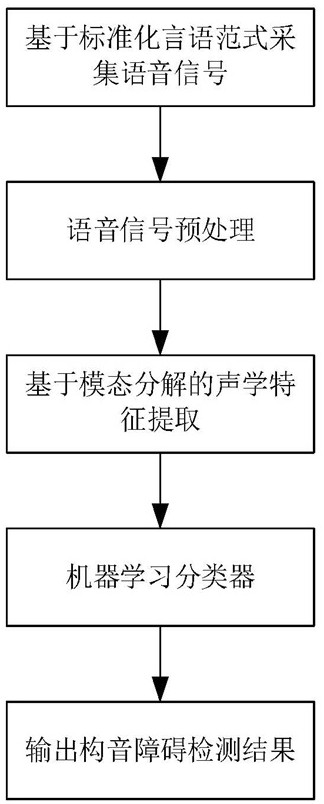Rapid dysarthria detection method based on modal decomposition
A technology for modal decomposition and dysarthria, applied in speech analysis, diagnostic recording/measurement, character and pattern recognition, etc., can solve problems such as poor robustness, ignoring the implicit information of the sound, and not considering the time-frequency characteristics of the sound
- Summary
- Abstract
- Description
- Claims
- Application Information
AI Technical Summary
Problems solved by technology
Method used
Image
Examples
Embodiment 1
[0113] 120 speech samples were collected, including 60 dysarthria patients and 60 sex- and age-matched healthy controls. All acoustic features are extracted and divided into training set and test set, and then the training set is input into the SVM model for training and cross-validation, and finally the experimental test is carried out on the test set. The final experimental results are shown in Table 1 below. In the first embodiment, the detection accuracy rate reaches 86.1%.
[0114] Table 1 Experimental results of dysarthria detection
[0115] Evaluation indicators Accuracy F1 Score AUC Numerical value 0.8611 0.8718 0.8302
[0116] To sum up, the present invention overcomes the limitation of traditional acoustic features in nonlinear time-varying systems, the decomposed IMF contains the time-frequency information of the original audio signal at different levels, and can well capture dysarthria patients The physiological information of speech r...
PUM
 Login to View More
Login to View More Abstract
Description
Claims
Application Information
 Login to View More
Login to View More - R&D
- Intellectual Property
- Life Sciences
- Materials
- Tech Scout
- Unparalleled Data Quality
- Higher Quality Content
- 60% Fewer Hallucinations
Browse by: Latest US Patents, China's latest patents, Technical Efficacy Thesaurus, Application Domain, Technology Topic, Popular Technical Reports.
© 2025 PatSnap. All rights reserved.Legal|Privacy policy|Modern Slavery Act Transparency Statement|Sitemap|About US| Contact US: help@patsnap.com



